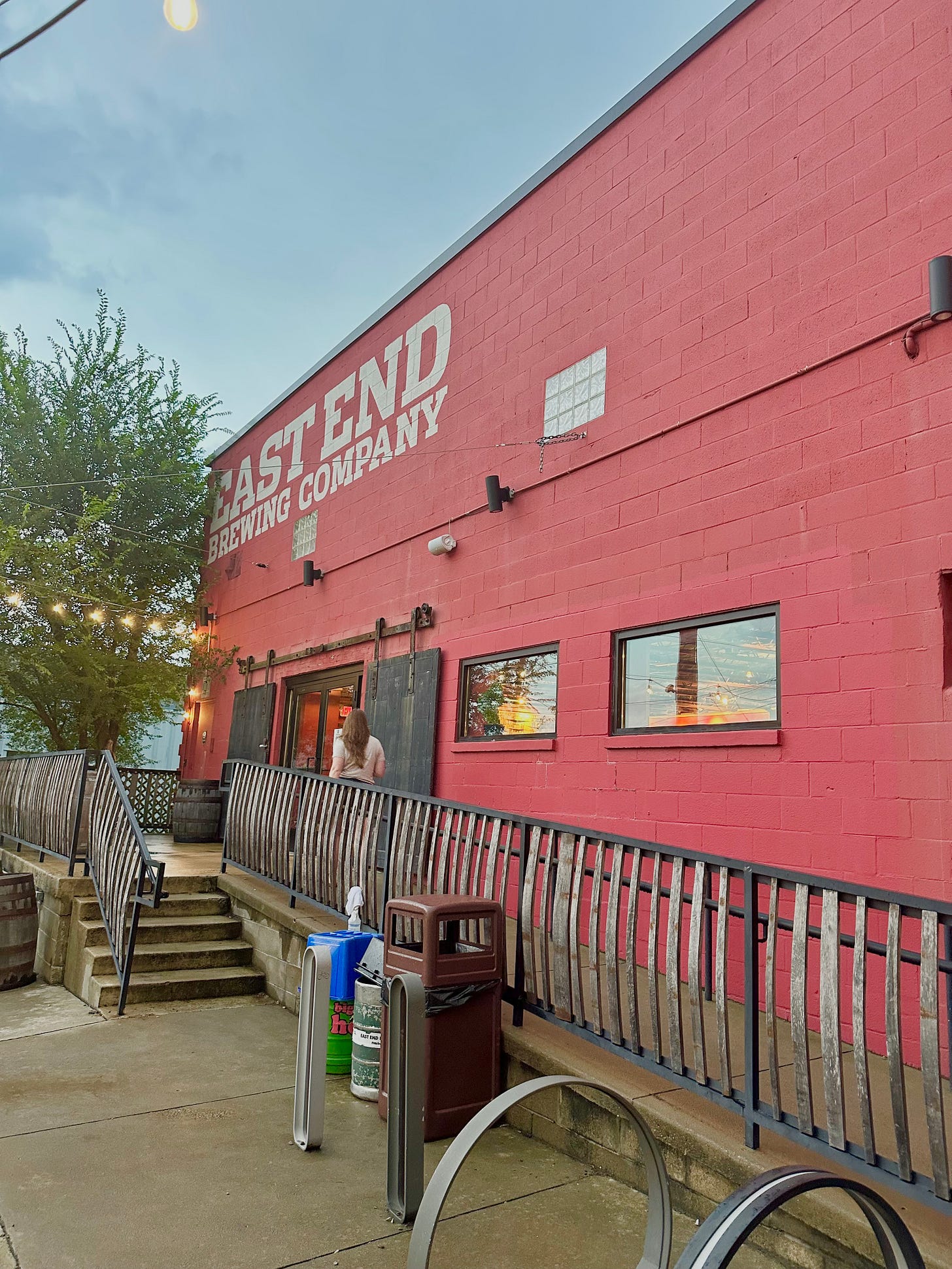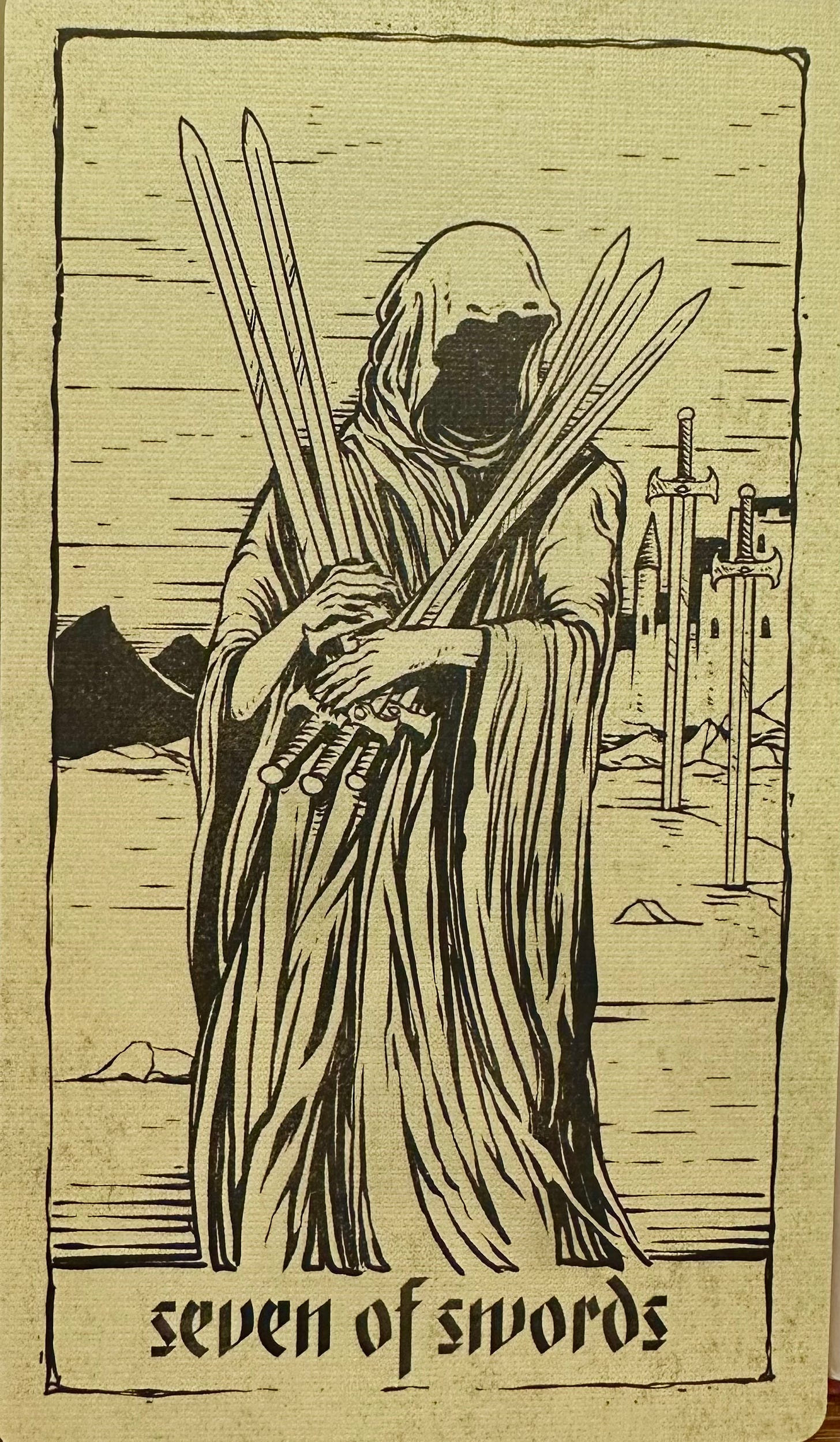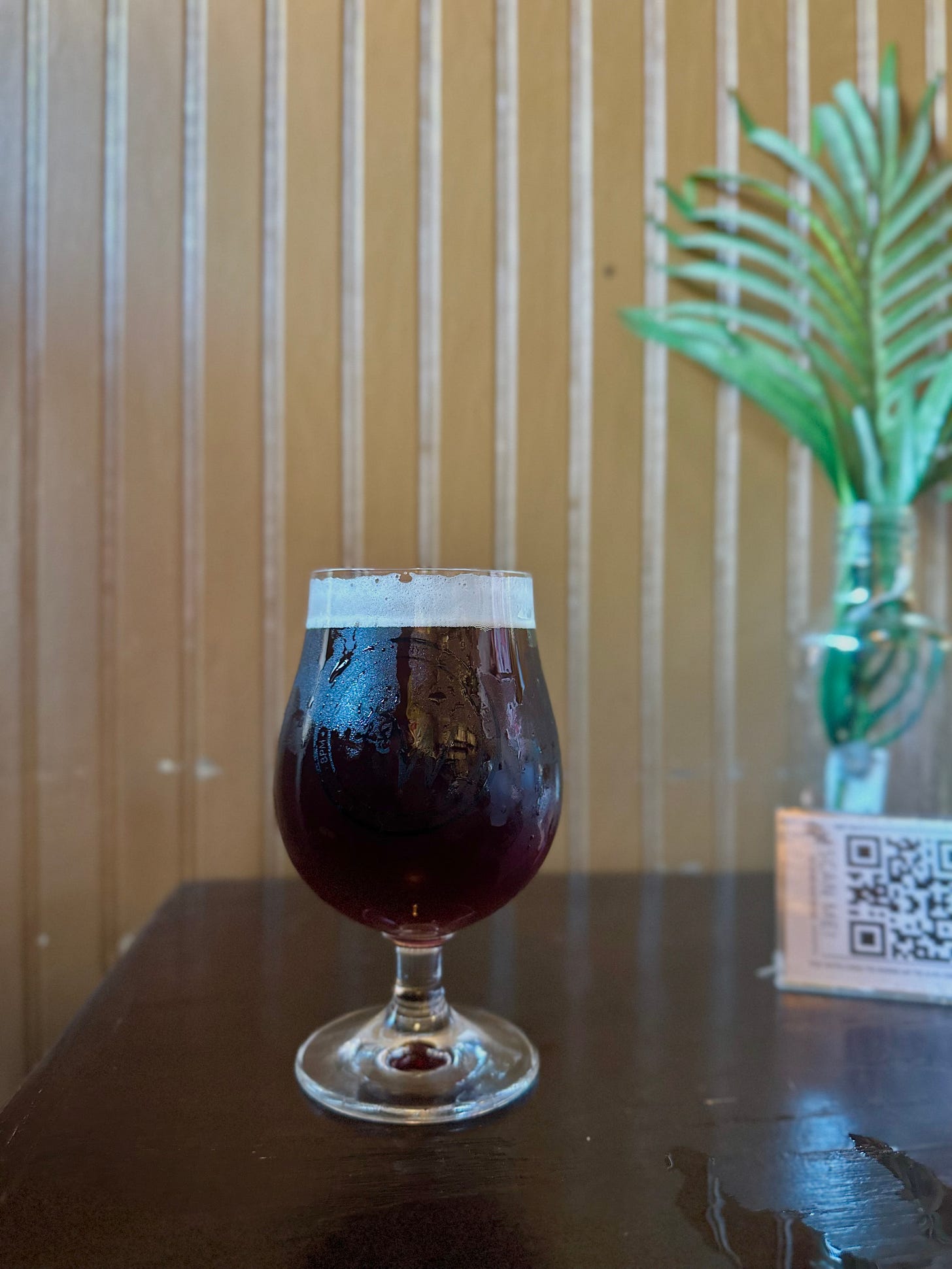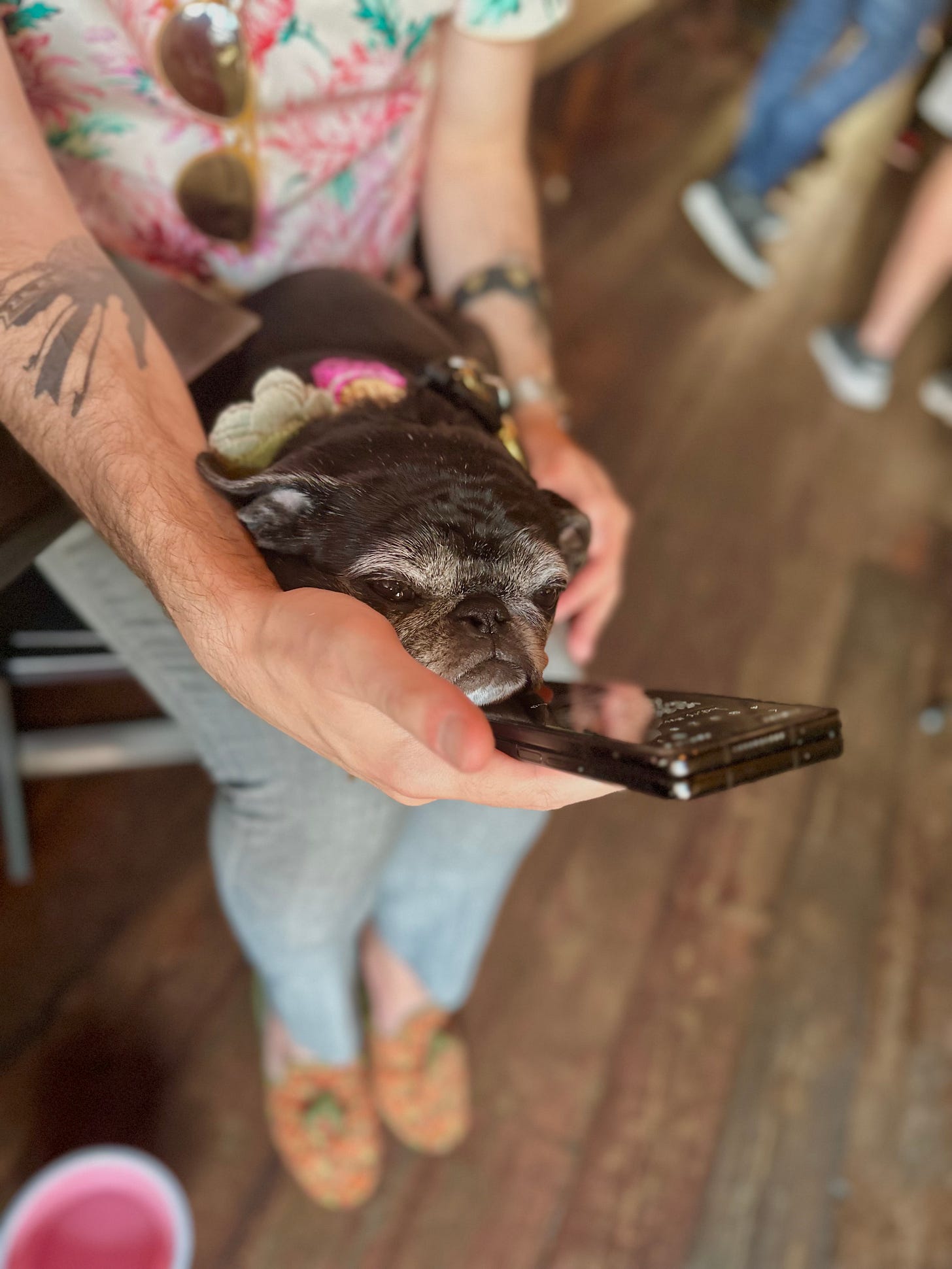103. On Pittsburgh: The Benefits of Keeping a Beer Scene's Sights Set on Local Community
Takeaways from sampling PGH's beer scene and its hyper-local focus, and how that's relevant in today's industry; plus tarot for your scheming and strategizing.
A Return to the Simple Goodness of Local-Local-Local, A Look Forward to Intentional Inclusivity
Last week, as I listed specific things I’m excited about in craft beer, I teased a couple of things from a recent visit to Pittsburgh. There’s so much more to discuss there that I wanted to devote an entire issue to this city, of which I’m now a pretty big fan.
First things first, though: a bit of a disclaimer. I visited Pittsburgh on a press trip, courtesy of Visit Pittsburgh. I am really strict with press trips. I do not go on any that require coverage as a non-negotiable condition, because I can and will never guarantee that. No shade to the organizers of these trips—they’re obviously incredibly expensive. But there are two hurdles for me to clear in order to cover something and neither are possible to ensure ahead of time: I’ve got to find a compelling story somewhere in there, organically…I’ve got to personally care and be intrigued by something, and see how it would engage and inform others; it can never, ever feel like a piece of branded content. That’s just not my deal nor is it my particular career track. And, I’ve got to get an editor to care, too. I only go on press trips where I can genuinely see potential for stories I’ll truly become invested in, and I’ve had a couple where I’ve indeed come back with several different ideas I thought were the bee’s knees—and no editor agreed with me. So, when I agreed to go check out Pittsburgh, I already had a hunch I’d find some cool stuff happening within its beer scene, and I can authentically, #notanad tell you that it surpassed my expectations.
We visited 11 breweries on this weekend trip. That sounds bonkers, and I was indeed a bit nervous heading into the itinerary. But as it turns out, when you hit a certain age and also a certain point of covering this industry and/or visiting breweries everywhere all the time, you know how to pace yourself—this is where the whole small-pour thing comes in very handy, and I’m happy to report every single place we visited had options. (We also somehow had time to hit other, non-beer Pittsburgh sites, and I won’t venture too much into them as you’re here for the beer, but…this really is a fun city and I really am sold.) My overall takeaway on Pittsburgh craft beer? It is somehow both a lovely look back, and a smart and exciting look forward.
11 breweries did feel like a lot in one weekend, but considering there are dozens more in the greater area we didn’t get to, I’m obviously open to any locals telling me anything I missed or didn’t get. But from this quick sampling, I felt like Pittsburgh breweries managed to earnestly capture those glory days of craft beer when just being a place making its own local product in a variety of styles with flavors for everyone was the headline. We’ve been on the topic of ways to remain excited about craft beer, and it seemed to me that brewers in Pittsburgh have this figured out. They’re still clearly jazzed about what they can do with water, hops, barley, and yeast. That shows in both their beer and the atmosphere of their taprooms.
The look forward comes in on both business and culture levels. For the former, I saw this overall emphasis on local-local-local from Pittsburgh breweries. They are serving their immediate communities and most don’t distribute beyond a few intentional partnerships nor do they have great ambitions to do so. Instead of opening themselves up to the volatile, over-saturated, overwhelmingly competitive retail market, these breweries are throwing their energy and resources into things like packed event schedules. Based on when different breweries opened, it seems like this was the modus operandi before the craft beer industry took this turn, and that it comes more out of a mission statement than a financial strategy. But, happy accident—this model happens to set Pittsburgh breweries up for what is most likely a smoother path to stability amid these rocky times. As for the culture aspect, you have a dedicated concentration on the aforementioned community as well as on inclusion. Last issue, I mentioned Trace Brewing’s vocational program—I’ll add that again here so you don’t even have to click back:
In Pittsburgh, Trace Brewing splits its year between two paid six-month internships in which BIPOC, LGBTQIA+ people, and/or women get to learn all aspects of the brewing process. You do not have to be in Pittsburgh to apply, by the way, so if this sounds like the opportunity you’ve been waiting for, check back on their website in September to apply for 2024!
In this way, there really is a nice balance to this city’s beer scene: it’s capturing that glory-days nostalgia in the beer and the atmosphere, but it’s not looking back at craft beer’s white dude-dominated culture; it’s looking forward to a more diverse community.
Some specific highlights: Bona Fide Beer Company felt more like a cozy and well-appointed English pub than your standard industrial taproom, and I couldn’t imagine not drinking their bitter with English two-row barley and specialty malts for that reason—it did not disappoint. Cinderlands Beer Co. manages to throw full dedication behind seemingly every big beer and beer-adjacent trend, with a hearty menu of lagers, hoppy ales, and options like dessert sours, hard seltzer, and hard tea—with a focus on on-site enjoyment over far-flung distro (backed up by its restaurant and full bar), that’s a lot of options for local imbibers. 11th Hour Brewing Co. had serious “quintessential neighborhood taproom” vibes, with big friend groups, people enjoying a pint solo while working, and dog parents and their buds hanging outside. For all of that unassuming-ness, though, 11th Hour skillfully straddles a line of bolder, flavor-explosion type beers and crisp, easy-drinking classics.
Because of how on-trend smash burgers are now and how well this spot does them with their own creative spins, Burgh’ers Brewing Company felt more like a hopping restaurant than a brewery—but if you did forget where you were for a moment, Italian-style pilsner, Pre-Prohibition lager, or an excellent Cold IPA can easily remind you. Dancing Gnome was one of the two breweries in town I knew enough to anticipate, having had their beer at festivals and having heard the hype. The massive space with a lively crowd is an experience for sure, and exudes a “craft beer is alive and well here, and it still gets folks excited, too” vibe. The IPAs are every bit as good as you want them to be, and while this spot feels a bit bigger and sleeker than your more neighborhood-y staples, I think breweries like this that splash out on a more national craft-beer stage can help drive beer tourism—maybe you come for the Dancing Gnome, stay for more fantastic breweries than you can possibly get to in one trip.
Hitchhiker Brewing was the other brewery I’d already heard good things about, and the space felt much more low-key, like a local favorite quietly churning out bangers. I loved their Myrcene IPA, but perhaps what impressed me more is that while I normally don’t love American-style sours, I was taken with one of theirs that was a peanut butter and raspberry jelly situation. They also had a soft-serve ice cream made with a peach sour, and while novelties like that too often fall short, it was so good. What a fun way to offer a different kind of beer experience, and get even people who don’t love beer involved.
It was quite cool to explore East End Brewing, considering their opening in 2004 really helped set the stage for Pittsburgh’s early craft beer scene growth and later flourishing. Their Almost Famous Ale is by far and away the best pickle beer I’ve ever had—it’s technically a cucumber gose with pickle spices, and it’s shockingly easy-drinking and so delicious. It’s also a nice ode to the city, between its pickle-ness (Pittsburgh has a whole pickle heritage thanks to Heinz) and it being a collaboration with famous local sandwich haven Primanti Bros. East End does not stop there when it comes to paying homage to its city, though—far from it. Its “You Are Here” series celebrates what it means to be a local brewery—and in that sense, really captures what’s great about Pittsburgh’s entire beer scene—with a beer for every one of the city’s 90 neighborhoods. Yes, 90. They’re actually almost at the end of the line, and you can see what neighborhoods were celebrated with what beers here. This is quite a cool way to recognize your local fans.
Thanks in large part to the aforementioned vocational program, Trace Brewing was one of my favorite visits, not just in Pittsburgh, but really generally speaking. I loved the beers that came out of their foeders—we tried a saison and a lager—as well as learning about their coolship program (they’re one of three breweries in the city to have one, and it’s obviously quite the tricky, timing- and dedication-demanding endeavor in an urban environment). And, of course, I was really interested in how Trace establishes itself beyond being a brewery. From a very intentional coffee program, which means they open at 8am and establishes them as the kind of place you can work at in the morning and kick back at in the evening, to a near-daily event roster with an emphasis on inclusivity, Trace obviously resonates with locals on a level bigger than beer.
The other day, this story about how craft breweries help economically fuel their local economies in upstate New York popped up in my feed. This dynamic is obviously more impactful and noticeable when local sourcing is involved, incorporating hop growers and maltsters, for example. But generally speaking, I found it an interesting contrast to all the apocalyptic reports of craft beer’s imminent death. Amid the sputtering and stagnating of craft beer, there are still pockets all over the country where breweries who concentrate on their immediate surroundings survive and even thrive, delighting locals and weekend visitors. It’s kind of nice, when you think about it—a world of craft beer beyond obsessively tracking every trend and rise and fall in, well, craft beer. Where taprooms are more about bringing people together with a simply good, house-made product. More of this, please.
Beer Tarot!
This week, I pulled the Seven of Swords.
Swords is the suit of intellect and decisions, and this card specifically deals with deceiving someone—and getting away with it, betrayal, scheming, strategy, and general sneaky mischief. Are you trying to get one over on someone or multiple people right now? Um, lol, quit it. Whether it’s a big, orchestrated plan (weird to imagine, like, a jewel thief reading this newsletter but I don’t know what all of you get up to in your own time) or you’re phoning it in at work, making it seem like you’re doing a great job, and potentially posing risks for others; or even just not being real with yourself and others about your true self or desires—or, even simply bullshitting everyone on Instagram…this card holds up a hand and says, “Whoa, buddy. You’d better slow your roll because this is not going anywhere good.” Let alone the fact that you could possibly hurt others, it’s almost a guarantee it will not end well for you. You’'ll be caught and in trouble or embarrassed, or, saving anything so dramatic, you’ll just be distracting yourself from what actually matters and what you actually want.
If none of this resonates with you, you may unfortunately have to do the uncomfortable task of thinking about different situations you’re in where someone else might be doing this to you. Have you been a bit wary of a certain new relationship—work, romance, or otherwise? Maybe it’s not just you. This isn’t a call to be paranoid, but just to be aware and listen to yourself and your instincts. On all fronts, be honest with yourself and others.
Two Beers Brewing Co. in Seattle has a beer called Deception Pass, and while it is not a pass to go out and be deceptive, it is a pass to drink a delicious beer while you have the deep think this card calls for. Truly, this one sounds lovely and refreshing—it’s a summer ale with Idaho 7 hops.
This Week’s Boozy Media Rec
Kate Bernot dives deep into a phenomenon increasingly relevant in craft beer now for PUNCH, which is…what happens when a beer so intrinsically tied to its local region (very on topic for this issue!) is suddenly brewed elsewhere? It’s something we’re seeing more and more as breweries get acquired or merge with other breweries or beverage companies. When a beer brand gets a change of address, does that compromise its whole ~legacy~? Can that ever be maintained or replicated? Does it even matter? Kate examines the different angles with—unsurprisingly!—tons of insight and smart reporting.
Event Shout-Out
If you’re a big Marlowe Artisanal Ales fan like I am, and you’re in the New York area, there’s an opening this Saturday you won’t want to miss. The New York Craft Coalition is opening its doors at 139 Hoyt Avenue in Mamaroneck at 11am on August 26. This is a collaborative project from Marlowe and Barclay Brewing, so expect fantastic, dialed-in beers forming an intentional tap list, and as much thought going into the food menu, too. For the grand opening celebration, there will also be guest beers from the likes of North Park, The Seed, and Phase Three. Congrats to Marlowe, Barclay, and the New York Craft Coalition—this will be a great addition to New York’s craft beer scene and I can’t wait to get there!
Ex-BEER-ience of the Week
This summer has been a chaotic whirlwind of travel. I’m not complaining—I’m very, very grateful and there have been some amazing experiences in recent weeks, with lots of opportunities to explore very different cities. But, you know…I’m tired. It was nothing short of heavenly to while away a rare quiet Sunday afternoon in one of my favorite bars, BierWax, this past weekend, with the perfect Moon Atlas amber ale from one of my favorite breweries, Wild East.
Until next week, here is Darby reminding us that phone time is never as important as nap time.








